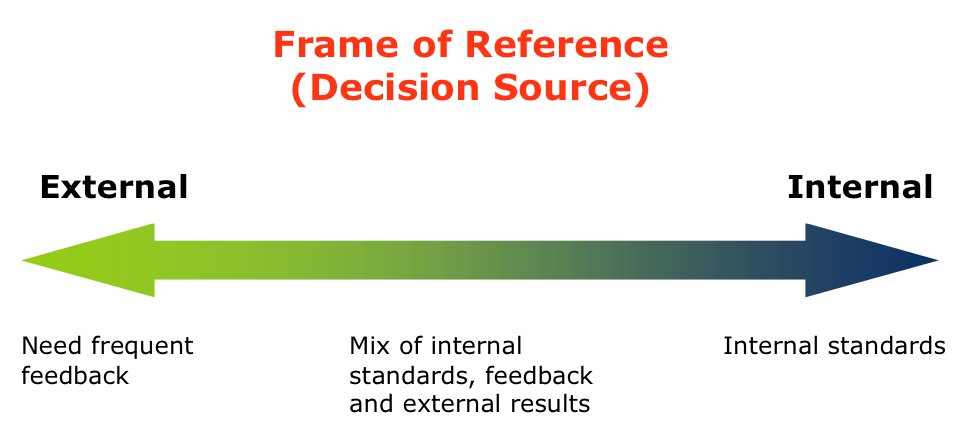
Internal/External
This is about how much feedback you consider you need.
The Internally Referenced person has internal standards that they use to assess how well they are doing, regardless of what anyone else says.
The Externally Referenced person actively needs feedback from others to stay motivated and confident that they are doing a good job.
Identifying the Internal/External pattern
This is a great interview question: simply ask “How do you know when you are doing a good job?”
Internal: ‘I just know’, ‘I feel it’, ‘my experience tells me’, ‘I decide’. They will refer to their own internal ‘evidence’.
External: ‘My manager/customers/colleagues tell me’.
For people in between the two extremes, you will get a mixture of the two answers, plus reference to objective external evidence e.g. targets hit.
Job role examples
Internally referenced people are good in back-office positions and those that require independent decision-making: leadership roles, technical specialists, the professions, creative artists.
Externally referenced people are good in any front-line role: customer service, retail, travel, hospitality.
Usually people become more internally-referenced as they spend time in a role and build up a ‘database’ of reference experiences to base their decisions on.
Ideally, a person in a new role, or coming onto a training course (such as an NLP Practitioner course) will start out externally referenced and gradually become more internally referenced over time. This enables them to take on information in the early stages and become confident in applying what they have learned as they become more experienced.
Influencing and managing
Internal: as you know, only you can decide, you may want to think about, this is just a suggestion, what do you want to have happen?
External: people are saying, research shows, they’re not happy, this is what you could do, I’ve noticed that, the boss says.
Externally motivated people need frequent feedback. If they don’t get any from their boss, they will become apprehensive as the annual appraisal gets nearer, because they literally will not know how they have been doing.
If you are a strongly internally-referenced manager in charge of a strongly ‘external’ person, do whatever it takes to remember to give them more feedback than you would require yourself.
Externally-referenced people may take information or inquiries about the current state of some task as an instruction to do something about it, even if that’s not what the inquirer intended.
Internally motivated people treat instructions from their manager as just more information; they will act as and when they see fit. Ideally, you will allow them to make their own decisions (or think they are making them, hence the use of influencing patterns such as ‘only you can decide’ – having set out the facts to point to a particular decision – and ‘as you know’ – before telling them something they don’t know).
Find out what motivates the internally-referenced person and see that they get it. Feedback will not have much impact on them. If you have a strongly internally-referenced person on a training course, you may have to arrange an experience that demonstrates to them that they don’t already know everything there is to know about what they are supposed to be learning.

Responses